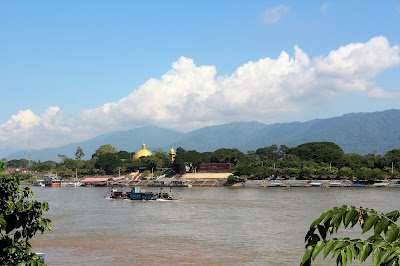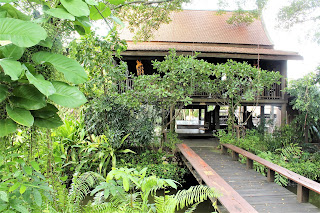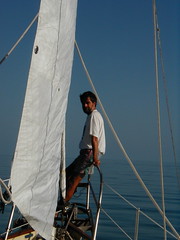 .
.Chian Rai lies 860 km north of Bangkok and is the largest city of Northern Thailand. The city lies on the flat alluvial plain of the Mae Kok River, a tributary of the Mekong river.
Founded in the 13th century, it belonged to Burma (today's Myanmar) and only became part of Thailand around 1899!

Our hotel, the Dusit Island Resort, was in fact located on the Kok river not very far away from Chian Rai city. In this heat, its pool was very inviting and it was most difficult to leave the resort in order to take the shuttle for a visit of the night bazaar. After Chian Mai's bazaar, it is the second largest of the country. A not to miss opporunity!
We went early so the crowds were not too big. The food stalls were amazing! Unfortunately, due to our flu, our appetite was not very big. Nevertheless, the colours and smells were very intriguing. Unfortunately, our guide was not with us and there were many items we could not identify!!!
A long-tail boat ride to visit the Karen village took a good hour. Traveling on long-tail boats was delightful despite the fact that our skipper had problems with its engine and was not able to really speed up to keep up with the other captains!

The Kok river is a wide, shallow, and slow-moving river. Its shores were pleasants and enabled us a view of people and animal habitats.

Hill dwelling peoples (7 major tribes within Thailand) each with a distinct language and culture.have traditionally been primarily subsistence farmers who use slash-and-burn agricultural techniques to farm their heavily forested communities. After the soil was depleted, the people would leave the area. Hence, their lifestyle was of a very nomadic nature.

Our hotel, the Dusit Island Resort, was in fact located on the Kok river not very far away from Chian Rai city. In this heat, its pool was very inviting and it was most difficult to leave the resort in order to take the shuttle for a visit of the night bazaar. After Chian Mai's bazaar, it is the second largest of the country. A not to miss opporunity!
We went early so the crowds were not too big. The food stalls were amazing! Unfortunately, due to our flu, our appetite was not very big. Nevertheless, the colours and smells were very intriguing. Unfortunately, our guide was not with us and there were many items we could not identify!!!
A long-tail boat ride to visit the Karen village took a good hour. Traveling on long-tail boats was delightful despite the fact that our skipper had problems with its engine and was not able to really speed up to keep up with the other captains!

The Kok river is a wide, shallow, and slow-moving river. Its shores were pleasants and enabled us a view of people and animal habitats.

Hill dwelling peoples (7 major tribes within Thailand) each with a distinct language and culture.have traditionally been primarily subsistence farmers who use slash-and-burn agricultural techniques to farm their heavily forested communities. After the soil was depleted, the people would leave the area. Hence, their lifestyle was of a very nomadic nature.
The negative impact of slash and burn practices on the environment, as well as concerns over borderland security and population pressure has led to forcible relocation of many hill tribe peoples.

Survival for these people is a challenge: while they still practice some kind of agriculture, their lives have changed. Cultural travel tourism bringing visitors to their villages has become an increasing source of income.
While we have ambiguous feelings towards this type of tourism, we must admit that it does provide income to these people and encourages them to produce their traditional crafts. How successful is it to keep the young generation out of trouble (i.e. prostitution in cities like Bangkok) ? So, as we did when we cruised in the Caribbean, we chose to encourage to local economy, one way or another!
Our destination the Karen village, home to more than 1500 families of various hill tribes, has been developped with the hope to make it a tourist destination where visitors can get a glimpse of the hill tribe's way of life.
Karen traditional clothing, typical for the V neck garments.
Rice cultivation: here the rice dries before being processed.
Karen woman in her small house: she created wonderful weaved pieces of clothing: here she is holding a blue scarf that Marleyne bought for her sister.
As we were leaving the compound, a small lady of the Akha people came to greet us: despite the heat, she was wearing her traditional multi-layered costume, hoping for a small offering....of course, we greeted her with a bow (no language skills required!) thanking her for being there for our pleasure and curiosity.
 We continued our travel to the Golden Triangle border, that special place where Thailand, Laos, and Myanmar meet. The area is separated by the Ruak and the Mekong rivers. This region has long been renowned as one of the world's largest opium production area. Most of the world's heroin came from the Golden Triangle until the early 21st century when Afghanistan became the world's largest producer.
We continued our travel to the Golden Triangle border, that special place where Thailand, Laos, and Myanmar meet. The area is separated by the Ruak and the Mekong rivers. This region has long been renowned as one of the world's largest opium production area. Most of the world's heroin came from the Golden Triangle until the early 21st century when Afghanistan became the world's largest producer.
On the left, Myanmar (anciently, Burma).

On the right, Laos.
Our restaurant was perched on a small hill and enabled us to admire this beautiful region. Sometimes, we had to pinch ourselves ..are we really that far away? Laos, Burma, Mekong river ...
 The Phra Sihing Buddha image (white) in the Bhumisparsha pose (earth touching gesture) is believed to originate from Sri Lanka.
The Phra Sihing Buddha image (white) in the Bhumisparsha pose (earth touching gesture) is believed to originate from Sri Lanka.
A stunning Cannonball tree or Sala Lanka tree throned in the temple's garden. This tree is significant for the Buddhists: In Hindu tradition, the sal tree is said to be favoured by Vishnu. It is said that Queen Māyā of Sakya gave birth to Gautama Buddha under a sal tree! It s flowers have a very sweet smell. All parts of that tree have diverse uses in addition to its religious significance.

 The main building at the white temple is reached by crossing a bridge over a small lake. In front of the bridge are hundreds of outreaching hands that symbolize unrestrained desire. The bridge proclaims that the way to happiness is by foregoing temptation, greed, and desire.
The main building at the white temple is reached by crossing a bridge over a small lake. In front of the bridge are hundreds of outreaching hands that symbolize unrestrained desire. The bridge proclaims that the way to happiness is by foregoing temptation, greed, and desire.
As in all buddhist temples, one can buy amulettes with the name of a deceased loved one for whom the monks will pray...another prayer for Marleyne's mother! As you can see, thousands of amulettes ornated that post...the monks are kept busy!
 The stretch from Chian Rai to Chian Mai takes 3 to 4 hours by coach. As can be seen on this map, we really were able to enjoy the montainous landscape of the country, hugged between Myanmar and Laos. So much to see...
The stretch from Chian Rai to Chian Mai takes 3 to 4 hours by coach. As can be seen on this map, we really were able to enjoy the montainous landscape of the country, hugged between Myanmar and Laos. So much to see... On Sunday, we drove up from Chiang Mai city to the site of the Wat Phra That Doi Suthep temple in trucks (songthaews). It was Sunday, very busy with cars and cyclists, but the ride was most pleasant...with the exception of the diesel fuels smells! Our guide distributed masks that we were happy to wear!
On Sunday, we drove up from Chiang Mai city to the site of the Wat Phra That Doi Suthep temple in trucks (songthaews). It was Sunday, very busy with cars and cyclists, but the ride was most pleasant...with the exception of the diesel fuels smells! Our guide distributed masks that we were happy to wear!
Wat Phra That Doi Suthep is located on a mountain named "Doi Suthep" and is a one of northern Thailand's most sacred temples. The wát is a beautiful example of northern Thai architecture (Lanna) that can be reached via a 306-step staircase: the climb is intended to help devotees accrue Buddhist merit. Our guide probably thought that merit in the eyes of Buddha was of lesser importance than our survival because she had us take an elevator to reach the summit!
 The site of the temple was very enticing: once we reached the top, the first striking structure of the temple is the the golden Chedi which dominates the area with its gilded, 24 meter tall bulk. At the rear of the temple a long promenade provides a spectacular view.
The site of the temple was very enticing: once we reached the top, the first striking structure of the temple is the the golden Chedi which dominates the area with its gilded, 24 meter tall bulk. At the rear of the temple a long promenade provides a spectacular view.


Heiner wrote our names and day of our visit on this cloth that, when filled with signatures, was wrapped around a wall.
The region of Chian Mai has many sites of interest for us, tourists. Besides temples, Thailand has flora and fauna related attractions that we were able to enjoy.
E L E P H A N T S!
 We spent delightful hours among these gentle giants at the Meataman Elephants camp.
We spent delightful hours among these gentle giants at the Meataman Elephants camp.For an interesting read on the status of elephants https://en.wikipedia.org/wiki/Elephants_in_Thailand
Here a mahout (elephant trainer) controlling an eager elephant ...bamboo stalks are a delicious snacks for them!!!These animals are not polite😉: if they see that you have a snack, they cannot wait and just grab it from you!! ! Very endearing, nevertheless!!
Elephants have a good memory and are very intelligent! Here we have an artistic one painting a self-portrait!
On a smaller scale, we visited an orchids farm...Thailand is famous for its cultivation of an astounding number of orchids!
And towards the end of our stay, we visited the Sampran Riverside, a family-run eco site that reunites natural and cultural attractions of Thailand. In fact, we had a somptuous lunch in the dining room after visiting the grounds and participated in activites such as flower design and clay sculpture.
 Sampran Riverside is an impressive farm and the dining experience is fabulous.
Sampran Riverside is an impressive farm and the dining experience is fabulous.The restaurant enjoys a plentiful supply of fresh herbs, coconut, vegetables and spices from their own certified Organic Farm across the river as well as other local organic farms.
Here in Thailand, we saw lotus flowers! In Shanghai, they were not blooming anymore because of the cold temperatures. Beautiful flowers!
We learned everything about rice culture: how young plants grow and are transplanted, how the rice is processed from field to table!
 Marleyne was far better at sculpture than flower design!
Marleyne was far better at sculpture than flower design!Do you recognize the elephant??? It made its way to Canada! with a bit of clay damage to one of its ear but, nevertheless!!!
Our afternoon at Sampran riverside ended with presentations of martial arts and traditional dance performances.
What about food????? It is very unlike Marleyne not to have zillions photos of food in one page of blog.
 Food was delicious in Thailand! Some establishments were outdoors restaurants , others had air conditioning. In some situations, the difference in temperatures (19C inside vs. 38C outside) was a little hard to take! Nevertheless, the food was very attractively prepared and delicious. Depending in what part of the country we found ourselves, we tasted regional specialties. One constant was the beer!!! Too hot for us to drink wine! Sometimes, our lunch was so generous (buffets) that we did not need a meal in the evening!!!
Food was delicious in Thailand! Some establishments were outdoors restaurants , others had air conditioning. In some situations, the difference in temperatures (19C inside vs. 38C outside) was a little hard to take! Nevertheless, the food was very attractively prepared and delicious. Depending in what part of the country we found ourselves, we tasted regional specialties. One constant was the beer!!! Too hot for us to drink wine! Sometimes, our lunch was so generous (buffets) that we did not need a meal in the evening!!!Here are some of the highlights:
 Sushis at the Bangkok Station Café! Their buffet was delicious and offered a good view of the Bangkok train station!
Sushis at the Bangkok Station Café! Their buffet was delicious and offered a good view of the Bangkok train station!And of course, one of the very memorable evening, in this Chian Mai hotel. Hostesses were carving amazing design in fresh produces. These young women incarnated the Thai beauty and grace and talent.
In Bangkok and Pattaya, we tasted authentic Thai food such as Tom Yum soup and Pad Thai!
And fresh seafood spiced with Thai red peppers! Now we know how to use them without killing our taste buds!!!
LAA GOÒN THAILAND!
The return trip was very long and tedious. Flying half-way around the world is strenuous enough but with delays, numerous security checks, and cold airports, the voyage was really taxing. Our flight itinerary was following: Bangkok to Hong Kong, 4.5 hours. Then Hong Kong to Vancouver, 12 hours. And finally Vancouver to Toronto, 4 hours.or so. But no regrets: it was a wonderful trip!










































































No comments:
Post a Comment